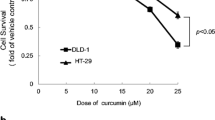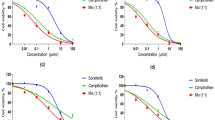Abstract
Hepatocellular carcinoma is chemoresistant to many anticancer drugs. Tunicamycin, an N-glycosylation inhibitor, causes unfolded protein response and is widely used as pharmacological inducer of endoplasmic reticulum stress. In this study, several designs were used to investigate the resistance mechanism to camptothecin and etoposide in hepatocellular carcinoma Hep3B cells. Tunicamycin significantly inhibited apoptosis induced by camptothecin or etoposide. Tunicamycin neither modified the topoisomerase levels nor inhibited the ATM activation caused by camptothecin and etoposide. The data suggest that tunicamycin-induced resistance may result from the downstream events of drug-trapped topoisomerase-DNA complexes and DNA double-strand breaks. Camptothecin and etoposide caused an increase of protein expression of several cell-cycle regulators and induced the cleavage of Bcl-2 family of proteins. These intracellular molecular events were abolished by tunicamycin. A design of postaddition of tunicamycin demonstrated that G1 checkpoint arrest contributed to the resistance mechanism. Curcumin, another G1 arrest-inducing agent in this study, was able to induce a similar resistant effect. Furthermore, the cells transfected with GRP78 siRNA were partly resistant to tunicamycin-induced apoptosis but not the inhibitory effect on cell-cycle regulators indicating that GRP78 and G1 arrest are two independent factors to tunicamycin-induced resistance mechanism. In conclusion, the data suggest that tunicamycin induces the resistance to topoisomerase inhibitors through GRP78 up-regulation and G1 arrest of the cell cycle. The findings also prompt the deliberation that the resistance can be caused during combined administration of chemotherapeutic drugs and Chinese herbal medicines, which induce endoplasmic reticulum stress and/or cell-cycle arrest in cancer cells.






Similar content being viewed by others
References
Castedo M, Perfettini JL, Roumier T, Kroemer G (2002) Cyclin-dependent kinase-1: linking apoptosis to cell cycle and mitotic catastrophe. Cell Death Differ 9:1287–1293
Chen AY, Liu LF (1994) DNA topoisomerases: essential enzymes and lethal targets. Annu Rev Pharmacol Toxicol 34:191–218
Ehrlichova M, Vaclavikova R, Ojima I, Pepe A, Kuznetsova LV, Chen J, Truksa J, Kovar J, Gut I (2005) Transport and cytotoxicity of paclitaxel, docetaxel, and novel taxanes in human breast cancer cells. Naunyn Schmiedebergs Arch Pharmacol 372:95–105
Ellgaard L, Molinari M, Helenius A (1999) Setting the standards: quality control in the secretory pathway. Science 286:1882–1888
Feldman DE, Chauhan V, Koong AC (2005) The unfolded protein response: a novel component of the hypoxic stress response in tumors. Mol Cancer Res 3:597–605
Guichard SM, Danks MK (1999) Topoisomerase enzymes as drug targets. Curr Opin Oncol 11:482–489
Gupta AK, Li B, Cerniglia GJ, Ahmed MS, Hahn SM, Maity A (2007) The HIV protease inhibitor nelfinavir downregulates Akt phosphorylation by inhibiting proteasomal activity and inducing the unfolded protein response. Neoplasia 9:271–278
Habraken Y, Piette J (2006) NF-κB activation by double-strand breaks. Biochem Pharmacol 72:1132–1141
Hsiao CJ, Ho YF, Hsu JT, Chang WL, Chen YC, Shen YC, Lyu PC, Guh JH (2008) Mana-Hox displays anticancer activity against prostate cancer cells through tubulin depolymerization and DNA damage stress. Naunyn Schmiedebergs Arch Pharmacol 378:599–608
Hsieh YH, Su IJ, Wang HC, Chang WW, Lei HY, Lai MD, Chang WT, Huang W (2004) Pre-S mutant surface antigens in chronic hepatitis B virus infection induce oxidative stress and DNA damage. Carcinogenesis 25:2023–2032
Hsu YL, Wu LY, Kuo PL (2009) Dehydrocostuslactone, a medicinal plant-derived sesquiterpene lactone, induces apoptosis coupled to endoplasmic reticulum stress in liver cancer cells. J Pharmacol Exp Ther 329:808–819
Lavin MF, Kozlov S (2007) ATM activation and DNA damage response. Cell Cycle 6:931–942
Li J, Lee AS (2006) Stress induction of GRP78/BiP and its role in cancer. Curr Mol Med 6:45–54
Li B, Gao B, Ye L, Han X, Wang W, Kong L, Fang X, Zeng Y, Zheng H, Li S, Wu Z, Ye L (2007) Hepatitis B virus X protein (HBx) activates ATF6 and IRE1-XBP1 pathways of unfolded protein response. Virus Res 124:44–49
Mazumder S, Gong B, Almasan A (2000) Cyclin E induction by genotoxic stress leads to apoptosis of hematopoietic cells. Oncogene 19:2828–2835
Ongkeko W, Ferguson DJ, Harris AL, Norbury C (1995) Inactivation of Cdc2 increases the level of apoptosis induced by DNA damage. J Cell Sci 108:2897–2904
Rao RV, Peel A, Logvinova A, del Rio G, Hermel E, Yokota T, Goldsmith PC, Ellerby LM, Ellerby HM, Bredesen DE (2002) Coupling endoplasmic reticulum stress to the cell death program: role of the ER chaperone GRP78. FEBS Lett 514:122–128
Rao RV, Ellerby HM, Bredesen DE (2004) Coupling endoplasmic reticulum stress to the cell death program. Cell Death Differ 11:372–380
Reddy RK, Mao C, Baumeister P, Austin RC, Kaufman RJ, Lee AS (2003) Endoplasmic reticulum chaperone protein GRP78 protects cells from apoptosis induced by topoisomerase inhibitors: role of ATP binding site in suppression of caspase-7 activation. J Biol Chem 278:20915–20924
Robert J (1999) Multidrug resistance in oncology: diagnostic and therapeutic approaches. Eur J Clin Invest 29:536–545
Roos WP, Kaina B (2006) DNA damage-induced cell death by apoptosis. Trends Mol Med 12:440–450
Shapiro GI (2006) Cyclin-dependent kinase pathways as targets for cancer treatment. J Clin Oncol 24:1770–1783
Shimada M, Takenaka K, Kawahara N, Yamamoto K, Shirabe K, Maehara Y, Sugimachi K (1996) Chemosensitivity in primary liver cancers: evaluation of the correlation between chemosensitivity and clinicopathological factors. Hepatogastroenterology 43:1159–1164
Sikic BI, Fisher GA, Lum BL, Halsey J, Beketic-Oreskovic L, Chen G (1997) Modulation and prevention of multidrug resistance by inhibitors of P-glycoprotein. Cancer Chemother Pharmacol 40(Suppl):S13–S19
Sorensen M, Sehested M, Christensen IJ, Larsen JK, Jensen PB (1998) Low-level resistance to camptothecin in a human small-cell lung cancer cell line without reduction in DNA topoisomerase I or drug-induced cleavable complex formation. Br J Cancer 77:2152–2161
Thews O, Gassner B, Kelleher DK, Schwerdt G, Gekle M (2006) Impact of extracellular acidity on the activity of P-glycoprotein and the cytotoxicity of chemotherapeutic drugs. Neoplasia 8:143–152
Tomida A, Yun J, Tsuruo T (1996) Glucose-regulated stresses induce resistance to camptothecin in human cancer cells. Int J Cancer 68:391–396
Wang Y, Wang W, Wang S, Wang J, Shao S, Wang Q (2008) Down-regulation of GRP78 is associated with the sensitivity of chemotherapy to VP-16 in small cell lung cancer NCI-H446 cells. BMC Cancer 8:372
Yeh TC, Chiang PC, Li TK, Hsu JL, Lin CJ, Wang SW, Peng CY, Guh JH (2007) Genistein induces apoptosis in human hepatocellular carcinomas via interaction of endoplasmic reticulum stress and mitochondrial insult. Biochem Pharmacol 73:782–792
Yoshida H, Haze K, Yanagi H, Yura T, Mori K (1998) Identification of the cis-acting endoplasmic reticulum stress response element responsible for transcriptional induction of mammalian glucose-regulated proteins. Involvement of basic leucine zipper transcription factors. J Biol Chem 273:33741–33749
Yun J, Tomida A, Nagata K, Tsuruo T (1995) Glucose-regulated stresses confer resistance to VP-16 in human cancer cells through a decreased expression of DNA topoisomerase II. Oncol Res 7:583–590
Zuco V, Zanchi C, Lanzi C, Beretta GL, Supino R, Pisano C, Barbarino M, Zanier R, Bucci F, Aulicino C, Carminati P, Zunino F (2005) Development of resistance to the atypical retinoid, ST1926, in the lung carcinoma cell line H460 is associated with reduced formation of DNA strand breaks and a defective DNA damage response. Neoplasia 7:667–677
Zuryn A, Grzanka A, Stepien A, Grzanka D, Debski R, Smolinski D (2007) Expression of cyclin A in human leukemia cell line HL-60 following treatment with doxorubicin and etoposide: the potential involvement of cyclin A in apoptosis. Oncol Rep 17:1013–1019
Acknowledgements
This work was supported by a research grant of the National Science Council of the Republic of China (95-2323-B-002-006 and 96-2323-B-002-004).
Author information
Authors and Affiliations
Corresponding author
Electronic Supplementary Material
Below is the link to the electronic supplementary material.
Supplement Figure 1
Examination of tunicamycin-induced resistant effect. The indicated agent was added to the cells for 48 h. After the treatment, the cells were collected, fixed, and stained with propidium iodide to analyze DNA content by FACScan flow cytometric analysis. Data are expressed as mean±SEM of four determinations. *P < 0.05 compared with the respective control (PPT 55 kb)
Rights and permissions
About this article
Cite this article
Hsu, JL., Chiang, PC. & Guh, JH. Tunicamycin induces resistance to camptothecin and etoposide in human hepatocellular carcinoma cells: role of cell-cycle arrest and GRP78. Naunyn-Schmied Arch Pharmacol 380, 373–382 (2009). https://doi.org/10.1007/s00210-009-0453-5
Received:
Accepted:
Published:
Issue Date:
DOI: https://doi.org/10.1007/s00210-009-0453-5




